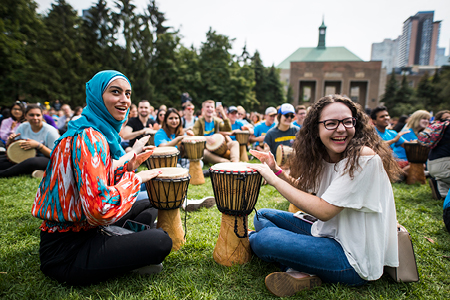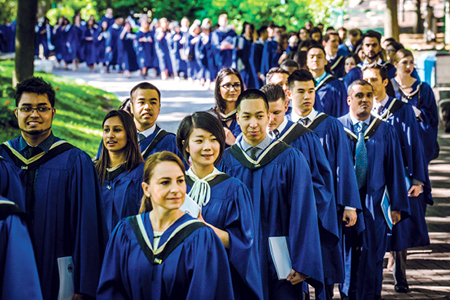Photography
Photography is the most effective tool to showcase the diverse, dynamic and transformative university we have become.
TMU’s photography style has been developed with our brand mission in mind. It portrays confidence for the university with an honest and authentic documentary-style approach.
When combining images in a single layout, using a mix of content and scales is most effective at communicating the breadth of work being done at TMU. Graphically, contrasting scales and content creates visual interest, helps to balance a layout and provides texture.
Principles of the Photography Style
- Capture candid and real moments.
- Focus on action and context to tell a story.
- Use straight-on angles.
- Capture portraits, city scenes and campus locations.
- Use close-up or detail shots to highlight projects.
- Use unfiltered, authentic colour and natural contrast.






In order to maintain a consistent brand message, it is important to avoid the following techniques in photography.

Avoid using photographs that are dramatically angled.

Avoid using images with an obvious shallow depth of field.

Avoid using photographs that appear staged and inauthentic.

Avoid isolating subjects from their visual context.

Avoid using photographs that are overly stylized or abstract.

Try to avoid using imagery that features legacy TMU branding.
External Photographers
Marketing and Creative Services, in University Relations has compiled a list of external photographers. The photographers on this list have been divided into two sets of categories to highlight their specialty – although all are available to cover whatever your photography needs may be. You may deal directly with them and make arrangements for your shoot as well as handle all financial matters related to the job.
Editorial, campaign and high-profile portraits
For example: magazine, brochures, advertisements, environmental portraits, photojournalism and campus images.
Events and standard portraits
For example: major and minor university events, department celebrations, awards ceremonies, convocation, headshots and simple portraits.
- Harry Choi
harrychoiphotography@gmail.com (opens in new window)
harrychoica.wordpress.com (external link, opens in new window) - Alyssa Faoro
mail@akFAORO.com (opens in new window)
akfaoro.com (external link) - John Packman
john@johnpackman.com (opens in new window)
johnpackman.com (external link) - Sid Tabak
sid@sidtabak.com (opens in new window)
sidtabak.com (external link)
TMU Asset Bank
For marketing photography needs such as campaigns and other materials, you can request access to the TMU Asset Bank. For access and instructions on use, please contact us.
Policy
The TMU Asset Bank is property of the university. These images are available under the condition that the photography supports the strategic promotion and marketing of the university and is for non-profit use.
With photography now dominating digital communication platforms as well as print, we need to revisit how the university works with photographers to ensure client needs are met and usage rights are clearly defined. Clarify the intended use of your photos in advance to get an accurate estimate that works within your budget. The following are key considerations to keep in mind when working with a photographer.
Usage
Before starting a project, it is important to clarify how your images will be used. There are two primary categories to be used for image licensing.
Project Specific: This licensing agreement means that the photographs purchased can only be used for a specific project (e.g., a photograph for a poster).
Multiple Use: This licensing agreement means that the final photographs purchased can be used on more than one application (e.g., mobile, social media, web).
Images
Before you begin a project it’s important to let your photographer know your photography needs, including how many images you’d like to receive.
Selected Images: You may choose to purchase a selected number of photographs from the photo-shoot. For example if your photographer shoots 100 photographs, you may agree to purchase only 30.
All Images: Another option is to purchase all photos from the photo-shoot. For example, if your photographer shoots 100 photos, you would receive all 100 photos.
Terms
It is important to discuss image ownership with your photographer before signing a contract. One way to think of photography terms is to clarify whether you want to rent the images or buy them outright. This distinction can help greatly in keeping a project within budget. There are two terms you can choose from.
Fixed Term: With a fixed term you can use the photographs for a specific length of time (e.g., one to two years), or one time only. For example, if you have an event or campaign that is more limited in scope you may only need one time usage.
Buyout: A buyout gives you full copyright ownership of all photographic images. These images can be used in perpetuity.
Contract: The submitted estimate by the photographer must include your agreed upon terms of use. Any updates or changes made to the terms must be amended in the estimate and sent back for client approval.
For all subjects that appear in-focus in your photos, you must obtain written permission to use their likeness for promotional usage. Download a (PDF file) general consent form or a (PDF file) minors and celebrities consent form. For event photography with large groups of people, download and print the (PDF file) notice of photography signage to display at the entrance of the event.